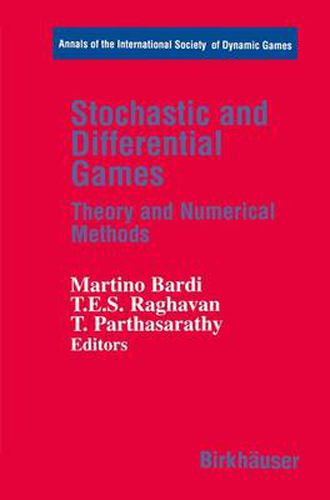Readings Newsletter
Become a Readings Member to make your shopping experience even easier.
Sign in or sign up for free!
You’re not far away from qualifying for FREE standard shipping within Australia
You’ve qualified for FREE standard shipping within Australia
The cart is loading…






This title is printed to order. This book may have been self-published. If so, we cannot guarantee the quality of the content. In the main most books will have gone through the editing process however some may not. We therefore suggest that you be aware of this before ordering this book. If in doubt check either the author or publisher’s details as we are unable to accept any returns unless they are faulty. Please contact us if you have any questions.
The theory of two-person, zero-sum differential games started at the be- ginning of the 1960s with the works of R. Isaacs in the United States and L. S. Pontryagin and his school in the former Soviet Union. Isaacs based his work on the Dynamic Programming method. He analyzed many special cases of the partial differential equation now called Hamilton- Jacobi-Isaacs-briefiy HJI-trying to solve them explicitly and synthe- sizing optimal feedbacks from the solution. He began a study of singular surfaces that was continued mainly by J. Breakwell and P. Bernhard and led to the explicit solution of some low-dimensional but highly nontriv- ial games; a recent survey of this theory can be found in the book by J. Lewin entitled Differential Games (Springer, 1994). Since the early stages of the theory, several authors worked on making the notion of value of a differential game precise and providing a rigorous derivation of the HJI equation, which does not have a classical solution in most cases; we mention here the works of W. Fleming, A. Friedman (see his book, Differential Games, Wiley, 1971), P. P. Varaiya, E. Roxin, R. J. Elliott and N. J. Kalton, N. N. Krasovskii, and A. I. Subbotin (see their book Po- sitional Differential Games, Nauka, 1974, and Springer, 1988), and L. D. Berkovitz. A major breakthrough was the introduction in the 1980s of two new notions of generalized solution for Hamilton-Jacobi equations, namely, viscosity solutions, by M. G. Crandall and P. -L.
$9.00 standard shipping within Australia
FREE standard shipping within Australia for orders over $100.00
Express & International shipping calculated at checkout
Stock availability can be subject to change without notice. We recommend calling the shop or contacting our online team to check availability of low stock items. Please see our Shopping Online page for more details.
This title is printed to order. This book may have been self-published. If so, we cannot guarantee the quality of the content. In the main most books will have gone through the editing process however some may not. We therefore suggest that you be aware of this before ordering this book. If in doubt check either the author or publisher’s details as we are unable to accept any returns unless they are faulty. Please contact us if you have any questions.
The theory of two-person, zero-sum differential games started at the be- ginning of the 1960s with the works of R. Isaacs in the United States and L. S. Pontryagin and his school in the former Soviet Union. Isaacs based his work on the Dynamic Programming method. He analyzed many special cases of the partial differential equation now called Hamilton- Jacobi-Isaacs-briefiy HJI-trying to solve them explicitly and synthe- sizing optimal feedbacks from the solution. He began a study of singular surfaces that was continued mainly by J. Breakwell and P. Bernhard and led to the explicit solution of some low-dimensional but highly nontriv- ial games; a recent survey of this theory can be found in the book by J. Lewin entitled Differential Games (Springer, 1994). Since the early stages of the theory, several authors worked on making the notion of value of a differential game precise and providing a rigorous derivation of the HJI equation, which does not have a classical solution in most cases; we mention here the works of W. Fleming, A. Friedman (see his book, Differential Games, Wiley, 1971), P. P. Varaiya, E. Roxin, R. J. Elliott and N. J. Kalton, N. N. Krasovskii, and A. I. Subbotin (see their book Po- sitional Differential Games, Nauka, 1974, and Springer, 1988), and L. D. Berkovitz. A major breakthrough was the introduction in the 1980s of two new notions of generalized solution for Hamilton-Jacobi equations, namely, viscosity solutions, by M. G. Crandall and P. -L.